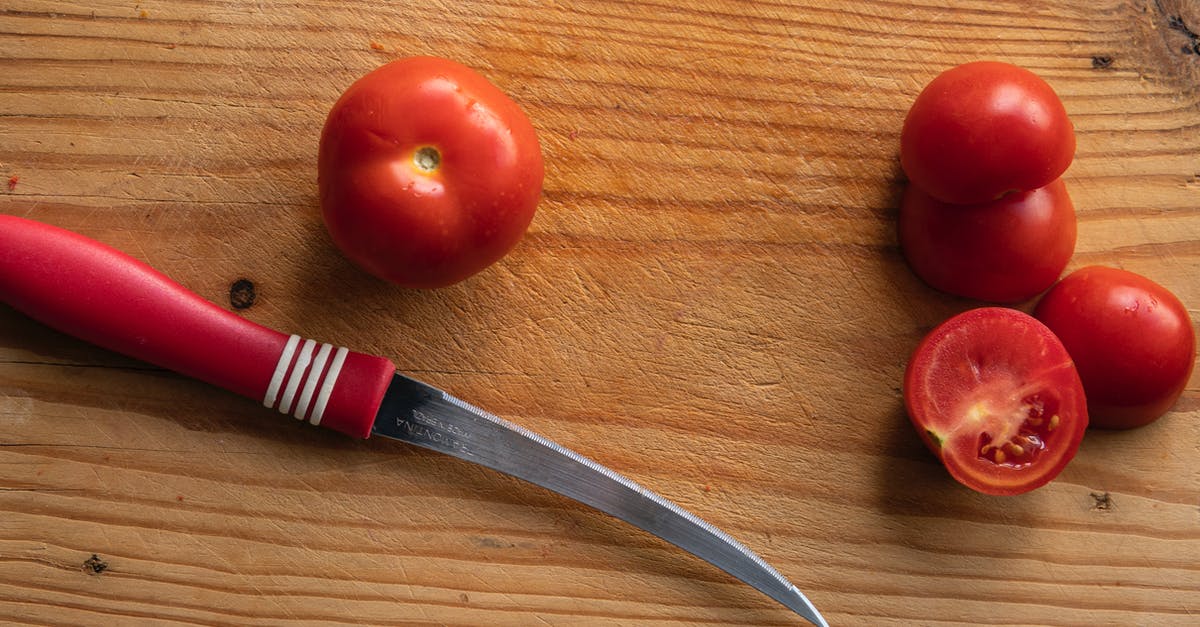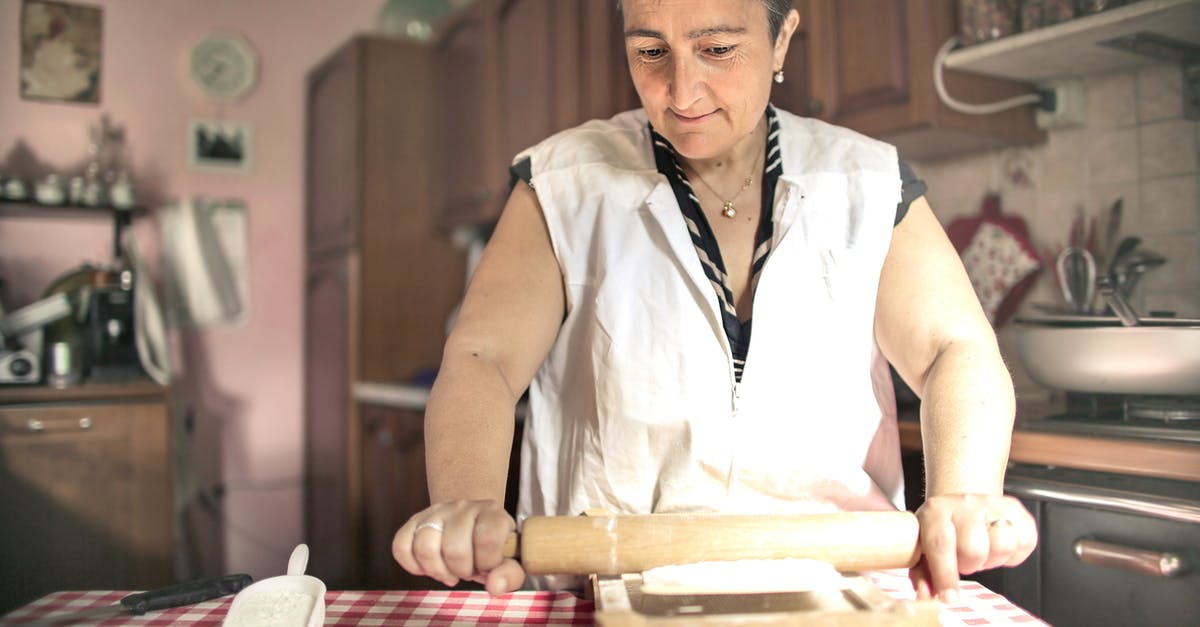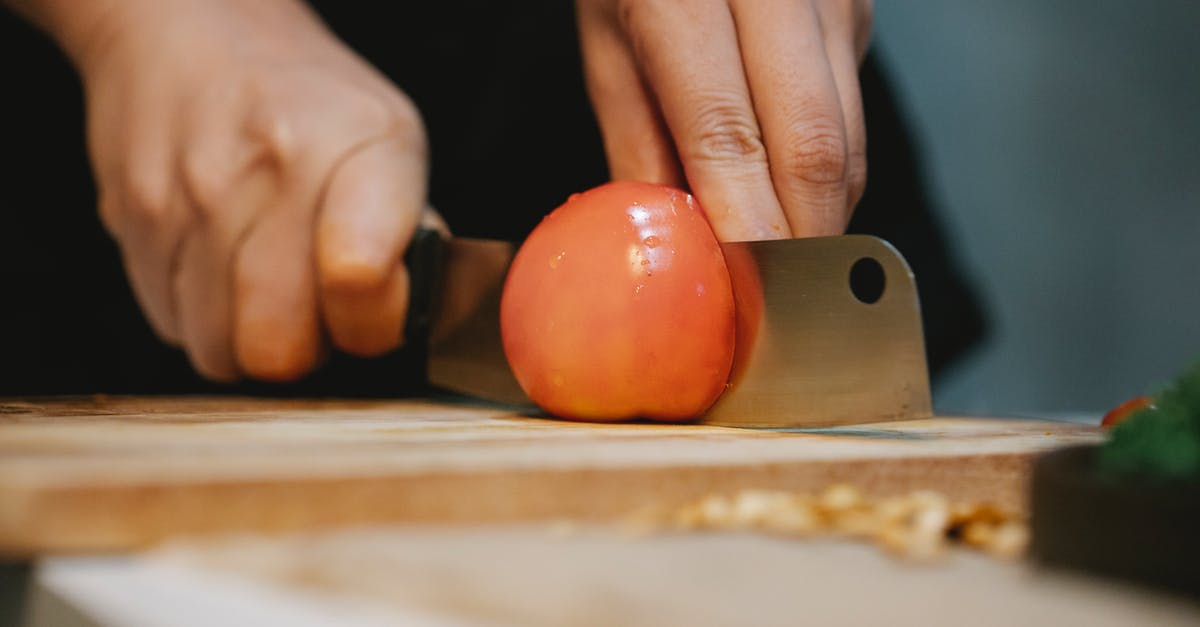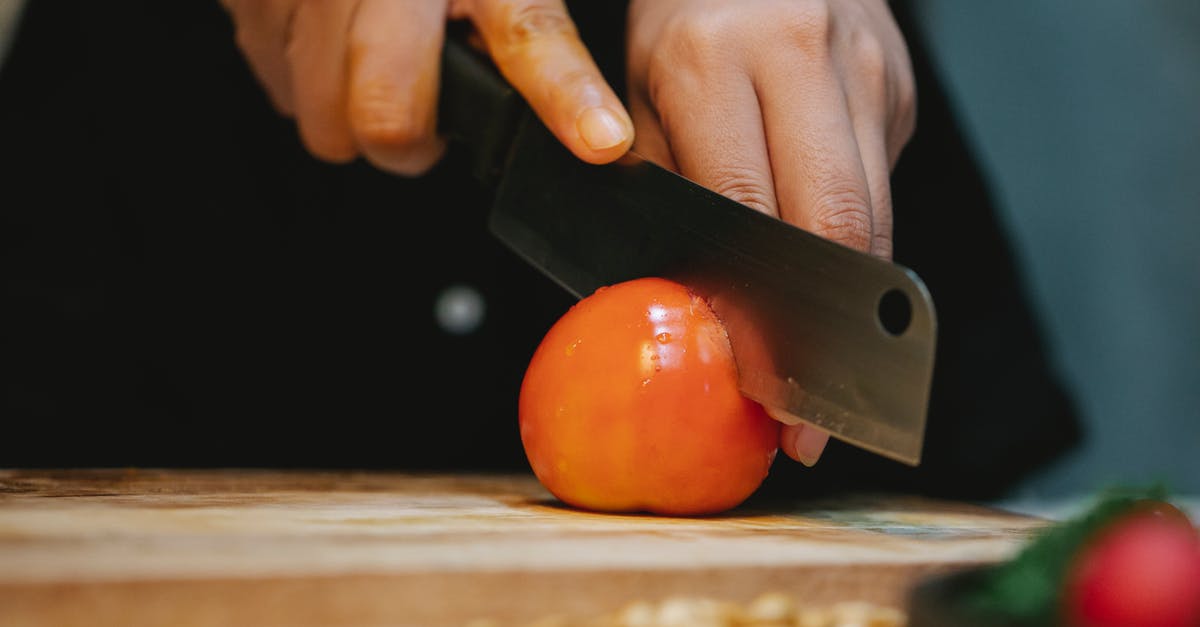How do you properly clean a cutting board and knife to prevent cross contamination?

I have one very nice cutting board that I like to use with my chef's knife. Because I only use this single cutting board and chef's knife, if I have a recipe that calls for cutting raw meat as well as vegetables, I have to take turns with the same board and knife. However, I'm always concerned that I haven't done enough to clean them after working with the meat before moving on the vegetables.
What do I need to do to properly clean the cutting board and knife to make sure that I avoid cross contaminating my tools?
Best Answer
Your primary defenses against cross-contamination include proper planning in the order of what you're cutting and proper cleaning between uses. In the case of your stew, simply cut the vegetables first and then cut your meat. Doing so in this order you won't need to wash the board between the vegetables and meat. If you want to expedite the cooking process, then either use a separate board for the meat first so that you can start browning it while cutting the vegetables, or simply wash and re-use the board. A good scrubbing with hot soapy water is fine for your knife and board (including wood boards).
As mentioned previously, if you're still concerned about bacteria you can rub the board with lemon juice or vinegar which will kill any residual bacteria.
Using separate boards that are relegated to specific meat vs. vegetable duty isn't necessary as long as you're properly cleaning your boards. A board only used for meat items is just as liable to transfer bacteria to the next item being cut on it if it isn't properly washed between uses. That being said, if you're properly cleaning them then it's fine to cut vegetables on a board that's also been used previously for meat.
As for cutting boards, your best bet for the care and maintenance for your knives are either wood or composite materials (usually a laminated product of paper and resin - "Epicurean" being a prominent brand.
Never use a tempered glass cutting board or other hard surface (granite, marble, Corian, etc.) as these are heavily damaging to the edge of your blade and unsafe for you as there is nothing for the knife to bite and grip into and it's much more likely to slip and cut you.
Plastic cutting boards and mats aren't very good on your knives and the boards in particular are either too hard and dull your blade prematurely or are soft and end up with lots of cuts and grooves which then trap food. People often have a false sense of security with plastic boards believing them to be "non-porous". As the board is used, food material ends up crammed into the cuts and grooves and while the boards can go into the dishwasher, that only removes the surface grime, not that which is impacted and over time you increase the potential for bacterial growth to occur.
Wood boards (including bamboo) are much better on your knives but to maintain them in good condition you need to properly maintain them. Periodically, when they look dry (kind of like chapped skin) you need to oil them with mineral oil. The mineral oil you buy at your local drugstore or grocery store pharmacy is fine, no need to buy fancy "block oil" in gourmet shops. Don't use vegetable based oils as they will go rancid and transfer the flavor to your food. I like to give the cutting board a heavy coating at night, let it soak in overnight, and then buff off anything that didn't soak in. This will keep your wood fibers soft and supple so that the board won't split and crack, the fibers will swell back together making it more "self-healing" as you cut on it, and the oil in the wood will repel liquids that would otherwise try to soak in. When a wooden board gets marred and nicked up you just need to take it to the garage and give it a good sanding before dusting off, rinsing and re-oiling.
Don't use bleach on boards (plastic or otherwise) as it will typically leave a distinct smell in the board.
Pictures about "How do you properly clean a cutting board and knife to prevent cross contamination?"



How can you avoid cross contamination when using cutting boards and knives?
Always use a clean cutting board. Wash cutting boards, dishes, and counter tops with hot, soapy water after preparing each food item and before you go on to the next item. If possible, use one cutting board for fresh produce and a separate one for raw meat, poultry, and seafood.What is the correct way to clean a cutting board?
Gently scrub your board with a sponge and hot, soapy water (we recommend using a mild unscented dish soap, such as Seventh Generation Free & Clear Dish Liquid). It's important to wash both sides of the board (even if you chopped on only one side) to prevent it from drying unevenly, which could cause the board to warp.What is the most sanitary way to clean a cutting board?
To clean a plastic cutting board, simply throw it in your dishwasher, or wash with dish soap and water by hand (you can also use a solution of a tablespoon of bleach per gallon of water to sanitize). To clean a wooden cutting board, warm water and soap work best.How should a cutting board be cleaned after each use?
Wood cutting boards need to be hand washed. After use, wash them with a bit of dish soap, rinse the board in hot water, wipe clean, and allow to dry upright. That's it\u2014it takes way longer for your plastic board to go through your dishwasher's wash cycle.More answers regarding how do you properly clean a cutting board and knife to prevent cross contamination?
Answer 2
Cut your vegetables first, then your meat. Clean both knife and board with hot, soapy water after you're finished. For a bonus, keep a dedicated poly cutting board for poultry. That way you can be certain that the only danger of salmonella is from poultry to poultry, which you're cooking to high temperatures anyway.
Answer 3
Vinegar and lemon juice will work if you let them sit for a few minutes after cleaning with mild soap and water (to remove hydrophobic fats). They will absorb into the wood a bit and kill whatever is lurking there. This isn't good for the wood.
I would recommend one of the cheap plastic flexible ones. You can bend them into a funnel shape to pour into pots/bowls, and they cost a buck or two a pop at ye olde box store.
For the knife, soap and water will work fine. Scrub a bit on the blade and handle.
You can use clorox or other chlorine bleach if you still feel paranoid, but this will make your wood cutting board smell like chlorine, probably for a long time.
Answer 4
Don't clean the wood cutting board with soap. Your best bet is to simply not use the wooden one for meat. Get a cheap plastic one (perhaps a larger, thicker one or a thin one depending on your tastes) and use that one for meat. You can clean that one with dish soap or bleach or whatever you wish.
Then just use the wooden one for vegetables and rise it off with cold water after each use.
For the knife, dish soap or bleach. Whatever you wish.
Answer 5
Here's the simple answer: use soap & hot water to clean your board and knife. That's it.
Read the USDA Food Safety and Inspection Service pages on cutting boards and food safety and preventing cross-contamination. There are heaps of more food safety info there, as well.
America's Test Kitchen confirmed this with actual bacteria cultures to see what worked.
tl;dr
- Soap & hot water is recommended for cleaning; use bleach dilute for sanitizing.
- Use one board for produce, one for meat/poultry/fish.
- Replace boards when they develop grooves where bacteria can hide.
Answer 6
DITTO: "Soap & hot water is recommended for cleaning use bleach dilute for sanitizing. Use one board for produce, one for meat/poultry/fish. Replace boards when they develop grooves where bacteria can hide."
In my kitchen I use separate colored boards for each group. I only use wooden cutting board for carving cooked meat. I also keep a small pan and spray bottle of dilute bleach for wipe ups.
Sources: Stack Exchange - This article follows the attribution requirements of Stack Exchange and is licensed under CC BY-SA 3.0.
Images: tugay aydın, Andrea Piacquadio, Klaus Nielsen, Klaus Nielsen
